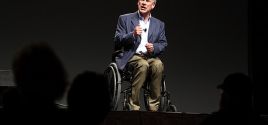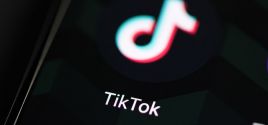Life in a CIA Torture CenterBy Stephen SoldzZNet Jun. 15, 2007 |
Popular 
Mike Johnson Pushes Debunked Lie That Israeli Babies Were 'Cooked in Ovens' On October 7

'It Has to Be Stopped': Netanyahu Demands Pro-Palestine Protests at U.S. Colleges Be Shut Down

'These Protesters Belong in Jail': Gov. Abbott Cheers Arrest of Pro-Palestine Protesters at UT Austin

Claim Jewish Student Was 'Stabbed In The Eye' by Pro-Palestine Protester Draws Mockery After Video Released

'We Aren't Going Anywhere': TikTok CEO Vows to Fight TikTok Ban in Court
 Late last week the Council of Europe released a report (.pdf) on the CIA's secret prisons in Eastern Europe. The report concluded that, contrary to those government's claims, that prisons existed in both Poland and Romania. Perhaps most importantly for opponents of torture, the report gives a detailed account inside one of these torture facilities. In this description we can see the results of decades of CIA study of how to destroy human beings, the fruits of its MKULTRA program and the detailed implementation of the in the KUBARK (.pdf) and other torture manuals. One of the problems the CIA faced in conducting their research on soul-destruction was the lack of available research subjects who could be subject to the full panoply of techniques or what they called "terminal experiments." It is thus likely that the CIA's psychologists, like Scott Shumate (who, according to his biographical statement "has been with several of the key apprehended terrorists"), were not involved solely in the construction of this hell, but also in studying its effects so as to better refine the techniques. Now, for a vision of life in hell: ii. Reconstructing the conditions in a CIA secret detention cell 38. We must try to visualise the ordeal of secret detention in order to be able to appreciate fully the physical and psychological plight of its victims. For this purpose, I am attempting in this section to reconstruct as many aspects as possible of the conditions in a CIA secret detention cell. 239. A reconstruction of this nature is the first step towards regaining respect for fundamental human rights, because it forces us to ask ourselves the question: "what if the tables were turned?" This is the root of the Geneva Conventions and the military's traditional reluctance to mistreat prisoners of war. 240. In this context, the policy debate in the United States around detainee treatment has given rise to interesting contributions, many of which rightly assert that "issues of detainee treatment raise profound questions of American values".212 In the US political sphere, the McCain Amendment213 to he Detainee Treatment Act seems to offer us a threshold for the specific acts that we should and should not allow with regard to the detention, transfer and interrogation of foreign captives. This threshold can be summarised as follows: If even one single American captive were to be held under these conditions or treated in this manner, and the American population would find it abhorrent or unacceptable, then America should not be practising the acts in question against detainees whom it holds from other countries 241. The fact of being detained outside any judicial or ICRC control in an unknown location is already a form of torture, as Louise Arbour, UN High Commissioner for Human Rights has said. All the member states of the Council of Europe have a duty not to tolerate such treatment either on their territory or elsewhere. 242. In the following paragraphs I seek to convey the most intimate, always undeniably human experiences of being held and interrogated in such conditions. I have grouped these conditions under the following five thematic headings: confinement, isolation and insufficient provision; careful physical conditioning of detainee and cell; permanent surveillance; mondane routine becomes unforgettable memories; and exertion of physical and psychological stress. 243. The descriptive testimonies on which the text is based have been kept strictly anonymous -- largely upon the request of those who provided them -- in order to protect the sources from which they emanate. These sources are mostly former or current detainees, human rights advocates, or people who have worked in the establishment or operations of CIA secret prisons. 244. The persons who endured these ordeals have also been granted anonymity. The following conditions and characteristics applied to several persons in every case, not specifically to any one individual. iii. Confinement, isolation and insufficient provision 245. Detainees were taken to their cells by strong people who wore black outfits, masks that covered their whole faces, and dark visors over their eyes. Clothes were cut up and torn off; many detainees were then kept naked for several weeks. 246. Detainees were only a bucket to urinate into, a bowl from which to eat breakfast and dinner (delivered at intervals, in silence) and a blanket. 247. Detainees went through months of solitary confinement and extreme sensory deprivation in cramped cells, shackled and handcuffed at all times. 248. Detainees were given old, black blankets that were too small to lie upon at the same time as attempting to cover oneself. 249. Detainees received unfamiliar food, like canned beef and rice, many only ate in order to give some warmth against cruel cold weather. 250. Food was raw, tasteless and was often tipped out carelessly on a shallow dish so part of it would waste. Apart from a thin foam mattress to lie on or rest against, many cells had a bare floor and blank walls. 251. At one point in 2004, eight persons were being kept together in one CIA facility in Europe, but were administered according to a strict regime of isolation. Contact between them through sight or sound was forbidden… and prevented unless it was expressly decided to create limited conditions where they could see or come into contact with one another because it would serve [the CIA's] intelligence-gathering objectives to allow it. 252. A common feature for many detainees was the four-month isolation regime. During this period of over 120 days, absolutely no human contact was granted with anyone but masked, silent guards. There's not meant to be anything to hold onto. No familiarity, no comfort, nobody to talk to, no way out. It's a long time to be all alone with your thoughts. a. Careful physical conditioning of detainee and cell 253. In the process of being transferred into secret detention, all detainees are physically screened in order to assess their health and conditioning, identify any injuries or scars they may bear, and get a complete picture to compare them against once they are in detention. These screenings, for which the subject is stripped naked, used a body chart, similar to the inventory diagrams provided by rent-a-car companies upon leasing a vehicle, on which specific marks are noted. In every case, the subject is videotaped or at least photographed naked before transfer. 254. The air in many cells emanated from a ventilation hole in the ceiling, which was often controlled to produce extremes of temperature: sometimes so hot one would gasp for breath,sometimes freezing cold. 255. Many detainees described air conditioning for deliberate discomfort. 256. Detainees were exposed at times to over-heating in the cell; at other times drafts of freezing breeze. 257. Detainees never experienced natural light or natural darkness, although most were blindfolded many times so they could see nothing. b. Permanent surveillance 258. Detainees speak hatefully about the surveillance cameras, positioned so that in every inch of the cell they would be observed. 259. Detainees were also listened to by interrogators, over hidden microphones in the walls. 260. Notwithstanding the presence of video cameras inside the cells, masked prison guards regularly looked in and knocked on the door of the cell, demanding detainees to raise their hands to show that they are alive. c. Mundane routines become unforgettable memories 261. Breakfast was delivered in the morning, followed by lunch in the early afternoon. The morning food was typically two or three triangles of cheese with no foil, two slices of tomato, some boiled potatoes, bread and olives. The afternoon food was typically boiled white rice with sliced luncheon meat. 262. On some special occasions, including certain religious holidays, special foods including cooked meat with sauce, nuts and dates, fresh fruit and vegetables, or pieces of chocolate were delivered to the cells. There was even provision for treats like unwrapped candy bars and dessert cakes. 263. Special routines developed around the delivery of food. The light bulb, which was always on, would be briefly turned off; the food would be delivered; and then the light bulb would be turned back on again. There was a hatch in the door of the cell for delivery of food but it was completelyunpredictable whether the guards would use the hatch, or open the doors and bring the food in. 264. Detainees had a bucket for a toilet, which was about a foot deep and ten inches in diameter. 265. At time the electricity supply went dead. The music stopped and the light went out. For a brief period one could heard different voices shouting, some more distant than others but all incoherent. d. Exertion of physical and psychological stress 266. There was a shackling ring in the wall of the cell, about half a metre up off the floor. Detainees' hands and feet were clamped in handcuffs and leg irons. Bodies were regularly forced into contorted shapes and chained to this ring for long, painful periods. 267. Most persons in CIA custody attempted sooner or later to resist or protest their treatment and interrogation. Yet their efforts would largely be in vain. According to one source involved in CIA interrogation: "you know they are starting to crack when they come back at you; when they get really vocal or they try to challenge your authority. So you hold out... you push them over the edge". 268. The sound most commonly heard in cells was a constant, low-level hum of white noise from loudspeakers. Other recollections speak of an external humming noise, like aircraft, engines or a generator. The constant noise was punctuated by blasts of loud Western music -- rock music, rap music and thumping beats, or distorted verses from the Koran, or irritating noises -- thunder, planes taking off, cackling laughter, the screams of women and children. 269. Detainees were subjected to relentless noise and disturbance were deprived of the chance to sleep. 270. The torture music was turned on, or at least made much louder, as punishment for perceived infractions like raising one's voice, calling out, or not waving quickly enough when guards demanded a response from you. 271. The gradual escalation of applied physical and psychological exertion, combined in some cases with more concentrated pressure periods for the purposes of interrogation, is said to have caused many of those held by the CIA to develop enduring psychiatric and mental problems. The report also describes why these details matter, why it is crucial for us, the free, to understand the prisoners and the conditions they are subject to: i. Re-humanising the people held in secret detention 232. The policy of secret detentions and renditions pursued by the current US administration has created a dangerous precedent of dehumanisation. Many of the people caught up in the CIA's global spider's web208 are rightly described as "ghost prisoners"209 because they have been made invisible for many years 233. Meanwhile the US Government's descriptions of its captives in the "war on terror" can only serve to exacerbate this dehumanising effect. The Administration routinely speaks of "aliens", "deadly enemies" and "faceless terrorists," with the clear intention of dehumanising its detainees in the eyes of the American population. The NGO community, for its part, calls them "ghost prisoners". 234. By characterising the people held in secret detention as "different" from us -- not as humans, but as ghosts, aliens or terrorists -- the US Government tries to lead us into the trap of thinking they are not like us, they are not subjects of the law, therefore their human rights do not deserve protection. 235. President Bush has laid this trap on multiple occasions as a means of diverting attention from the abusive conditions in which certain detainees in US custody are being held.211 Our team heard first-hand how distinctions are drawn in the mind of guards and interrogators: in an interview with one of our CIA sources who has extensive knowledge of detainee treatment, we asked whether a known form of detainee treatment should be considered as abusive. "Here's my question," replied our source. "Was the guy a terrorist? 'Cause if he's a terrorist then I figure he got what was coming to him. I've met a lot of them and one thing I know for sure is that they ain't human -- they ain't like you and me." 236. Yet what has struck me most often as I have examined the cases of scores of people held in secret detention -- some of whom I have met -- is precisely the opposite: these detainees' ordeals have affected me profoundly as I have always thought of them as fellow human beings. The worst criminals, even those who deserve the harshest punishment, must be given humane treatment and a fair trial. This, moreover, is what makes us a civilised society. 237. It is for these reasons that we must combat their being seen as "ghost prisoners" by repeatedly pointing out that persons detained in the course of counter-terrorist operations are and remain human beings whose human rights must be protected and who are entitled to humane treatment as laid down in the ECHR. In this section of my report I have set out expressly to place the emphasis on the human aspects of these people held in secret detention. We can be sure that the American Psychological Association, fond of issuing resolutions against torture as it is, will have not one word to utter about the existence of these torture centers or about the systematic use of psychological torture techniques in them. after all, the misuse of psychological knowledge for evil is no concern of the APA, if that evil is done by the United States government, with the aid of United States psychologists. The APA, after all, puts such psychologists on its decision-making panels rather than censure them. ________________ Stephen Soldz is a psychoanalyst, psychologist, public health researcher, and faculty member at the Boston Graduate School of Psychoanalysis. He maintains the Psychoanalysts for Peace and Justice web site and the Psyche, Science, and Society blog. |



